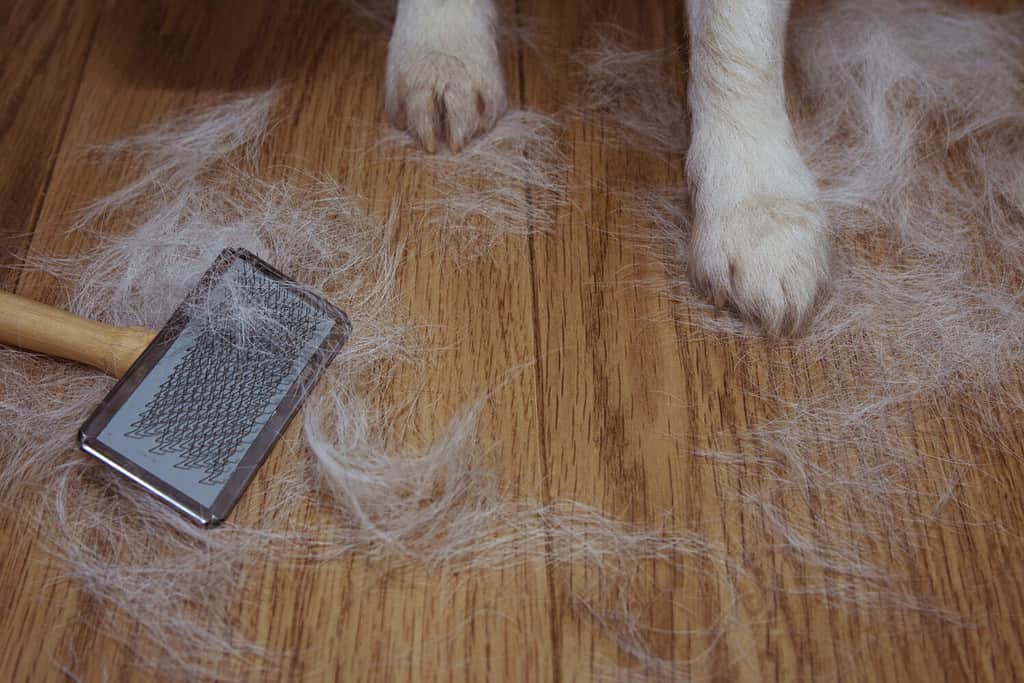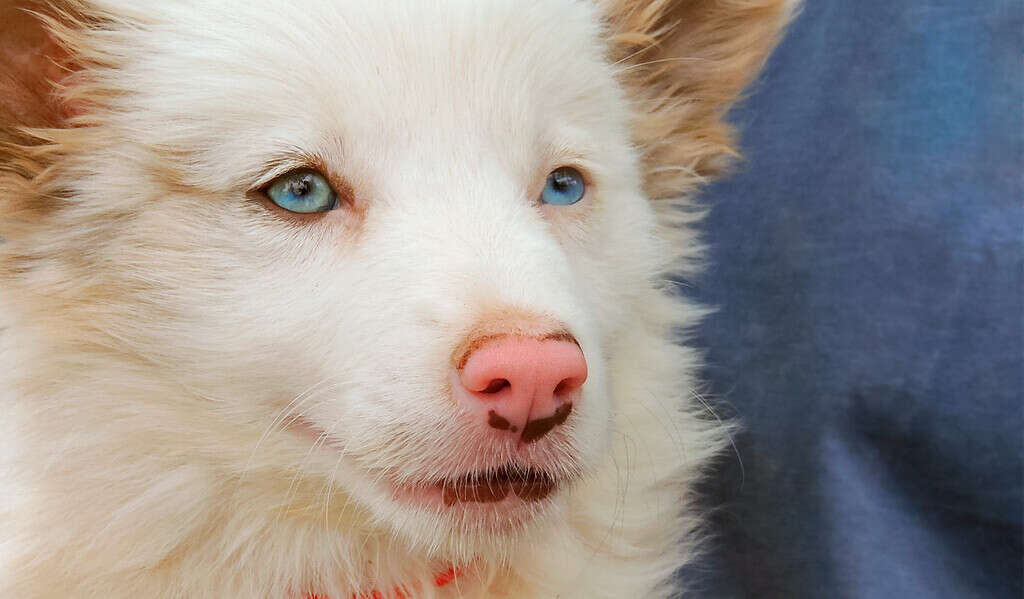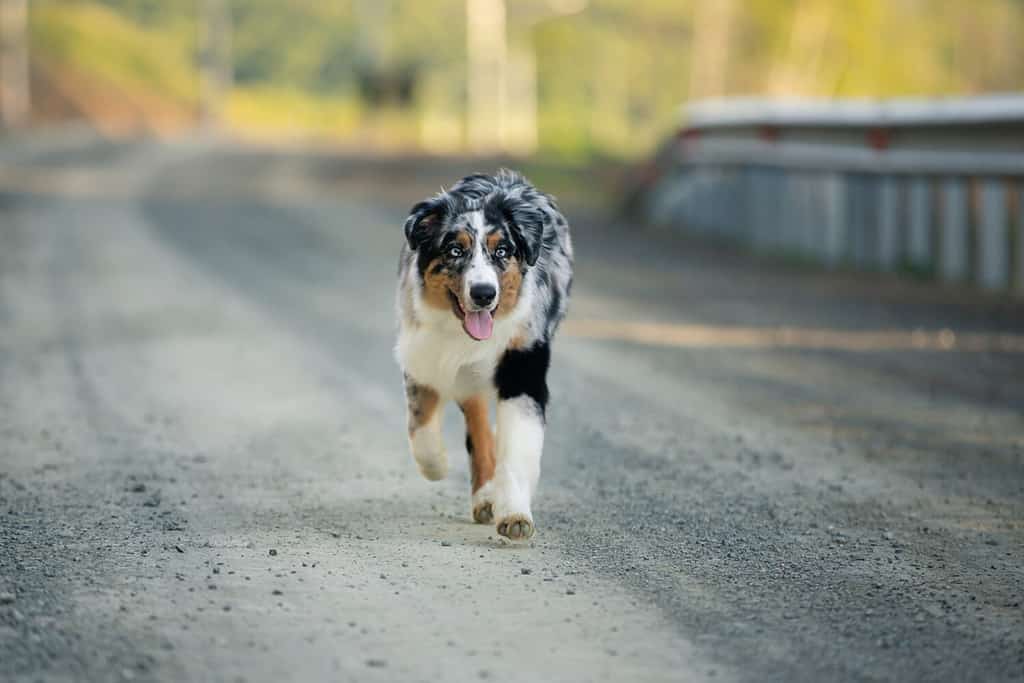Australian shepherds are very amiable and intelligent dogs. Bred initially as medium-sized working dogs, Aussies have a strong drive to complete tasks. They thrive on praise and affection for a job well done. Easy-going around other pets and playful with children, many people love Aussies as a family dog. However, like any breed, there are a few complaints some owners have with their Australian shepherd. Here are six common complaints about Australian shepherds and how to be proactive about them.
1. Separation Anxiety

Your Australian shepherd may suffer from separation anxiety if she exhibits destructive, compulsive, or depressive behaviors.
©Hanna Borysenko/Shutterstock.com
Aussies are very loyal, very affectionate dogs who thrive on attention. So, being left at home alone or separated from their owner can trigger a distress response. Here are some common signs your Aussie may be suffering from separation anxiety:
- Compulsive behaviors include pacing, excessive drooling, or compulsive licking (which leads to hot spots).
- Destructive episodes of furniture, doors, windows, etc.
- Excessive howling, barking, or whining.
- Depressive behaviors such as not eating, shaking, hiding, or panting.
- Indoor accidents of urinating or defecating.
The best way to help your Aussie to calm down is through exercise, preferably before you leave for work and when you return. Take your Aussie to a new trail a few times a week; not only will this get her moving, but the new environment is intellectually stimulating. If you can’t go outside, play a fun and challenging game with her with puzzle toys, tug-of-war, or go for a joy ride. As the saying goes, a tired Aussie is a good Aussie.
For more severe cases, many training facilities offer programs to help your dog tolerate the separation more healthily.
2. Shedding

For owners who can’t keep up with the brushing and maintenance of an Aussie’s coat, this breed might not be the right fit.
©smrm1977/Shutterstock.com
Aussies are medium to high shedders and shed all year round. The two heaviest seasons, like with most breeds, are in the spring and fall. This is due to their double coats. An Australian shepherd’s dense undercoat keeps Aussies warm and snug during the winter and cool during the summer. The outer coat is coarser and more weather-resistant.
The outer coat sheds lightly throughout the year, but the undercoat goes through a “blow coat.” That is when Australian shepherds shed their undercoats in bunches. During the spring, the undercoat changes to a lighter one for summer, and in the fall, the undercoat is cleared for a denser, warmer one for winter.
3. Eye Issues

Cataracts and distichiasis are the most common eye diseases in Aussies.
©Monique Oliveira/ iStock / Getty Images Plus via Getty Images
While Aussies have the most unusual and beautiful eyes compared to most dog breeds, they are genetically predisposed to some terrible eye diseases. Some examples include colobomas, cataracts, and detached retinas.
But, even though this is a common complaint of Australian shepherds, it doesn’t mean it will happen. Risk does not mean inevitable! Many Aussies live full lives without any issues. Be proactive with routine ophthalmology exams to catch any problems early.
4. Hip and Elbow Dysplasia

Untreated hip or elbow dysplasia may lead to painful arthritis for Australian shepherds.
©Anastasiia Cherniavskaia/Shutterstock.com
Dysplasia usually refers to abnormal growth or development of tissues or organs. In the case of the Australian shepherd, this breed is at risk of its hip or elbow sockets not developing correcting. This can cause the bones to rub or wear away at each other. In general, the entire area becomes inflamed, which leads to arthritis.
For preemptive care, have your veterinarian X-ray your puppy when she is at least two years old. If elbow or hip dysplasia is evident, you can talk with your veterinarian about solutions, such as medication or joint replacement surgery.
5. Skin Problems

Severe allergic reactions can lead to bacterial and yeast infections in Australian shepherds.
©Christian Mueller/Shutterstock.com
Aussies have sensitive skin, which is prone to skin allergies and infections. However, it is sometimes hard to detect irritated skin under your Australian shepherd’s thick, lovely coat. Detailed and thorough brushing of your dog will help you spot raw or infected skin. Typical allergy problem areas include the legs, paws, and hind end.
An Aussie’s allergies usually manifest around one or two years of age. Their severe immune response to pollen, dust mites, fleas, or foods will cause excessive biting, scratching, and rubbing to find relief.
For allergy relief, discuss options with your veterinarian. An oral or topical medication may be prescribed, and there are skin tests that may be done for environmental factors. Experimenting with your Aussie’s diet may also provide relief.
6. High Energy Needs

At least two to three hours of exercise—physical and mental—is necessary to keep your Australian shepherd from descending into destructive behaviors.
©ChocoPie/Shutterstock.com
Aussies are incredibly intelligent and highly sensitive to their surroundings. These qualities, combined with their athletic builds and high energy levels, make them fantastic herding dogs. Their keen sense of observation keeps the herd together and safe while also protecting the herd from any lurking dangers.
But, if an Australian shepherd is kept inside for long periods without anything to do, these valued skills can turn into destructive or aggressive behaviors. Aussies are not known to be aggressive dogs, so they are not on the banned list by home insurance companies. However, excessive amounts of inactivity and under-stimulation can cause this breed to chew or destroy things out of anxiousness. Or, you may notice extreme barking or rushing at strangers.
If you have low energy levels or health concerns that limit your activity, an Aussie might not be the best match. If you aren’t prepared to regularly exercise and challenge them, then you may have to deal with destructive and aggressive behaviors.
Summary of Common Complaints About Australian Shepherds
| Number | Complaint |
|---|---|
| #1 | Separation Anxiety |
| #2 | Shedding |
| #3 | Eye Issues |
| #4 | Hip and Elbow Dysplasia |
| #5 | Skin Problems |
| #6 | High Energy Needs |
The photo featured at the top of this post is © cynoclub/Shutterstock.com
Ready to discover the top 10 cutest dog breeds in the entire world?
How about the fastest dogs, the largest dogs and those that are -- quite frankly -- just the kindest dogs on the planet? Each day, AZ Animals sends out lists just like this to our thousands of email subscribers. And the best part? It's FREE. Join today by entering your email below.
Thank you for reading! Have some feedback for us? Contact the AZ Animals editorial team.







